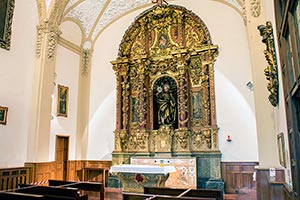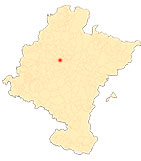Basilica of St. Ignatius of Loyola
By Ricardo Fernández Gracia
|
|
|
|
|
|
|
|
|
|
|
|
|
|
|
|
|
|
|
|
|
|
|
|
|
|
|
|
|
|
|
|
|
|
|
The basilica and its financing
Despite the crisis of the central decades of the 17th century, the construction of sanctuaries, especially Marian ones, was relatively important. Unlike those, supervised by their corresponding patrons and designed by the masters of the land, the Ignatian sanctuary of Pamplona was inspected by the Jesuits, who counted among their members with tracists and architects of all solvency, as well as excellent administrators.
There is a rich correspondence between Father Juan de Ribadeneyra, procurator of the Jesuits for the affairs of the Indies, and Father Baltasar López († Pamplona, 1670), closely related to the Diputación del Reino for having been its agent in the lawsuit of the co-patronage. We also know that the Andalusian Jesuits, in charge of collecting the money that arrived from the Indies, proposed in 1662 the erection of a triumph, similar to that of the Inmaculada in Granada, the work of Alonso de Mena (1628-1631). The people of Pamplona, anchored in tradition, suggested a humble shrine. Both ideas were discarded, and the next step was to plan the building, in which Brother Alonso Gómez, resident in Genoa, intervened at the end of 1668, specifying with Father López the layout, with a combined longitudinal plan, covered by barrel vaults with lunettes and a dome.
As we have indicated, the first amount arrived from the Jesuit Province of Peru, where 2,000 pesos were collected. We should also mention the 500 pesos sent from the Indies by Father Hernando de Labayen, a native of Berrioplano, who also sent silver bequests for the Virgin of Codés. Likewise, the 500 ducats given by the prior of the cathedral, Don Juan de Echalaz, as well as the donations of the future provincial of Castile, Father Antonio Carabeo, of Don Martín de San Martín, accountant of azogues and tributes of New Spain, or the salary of historian of the kingdom contributed by Father Francisco Alesón stand out. In the end, when the funds were exhausted, the President of the high school of Pamplona, Father Ignacio Zabala, asked for the "salary of the captain of St. Ignatius" to apply it to the factory.
The aforementioned President asked "that a reformed captain's salary, in the form of the others who serve in this presidio, be released and paid perpetually", taking into account that the saint "defended the castle of this city... where he was wounded and had the principle of having consecrated himself... to the greater glory and honor of God, for which purpose he founded the Society of Jesus". The viceroy answered in the affirmative, ordering to pay
his salary in the manner of the others who serve in this prison, whose portion is to be submit to Father President who is and henceforth will be of the house of the Company of this city, to continue in the work of the chapel or Shrine of Our Lady of Fair Love that is being built in the door of San Nicolas, and after this is finished, this salary will be applied to the support of two poor people.
file Diocesan of Pamplona. Government of the Diocese. administrative office de Cámara. Boxes 293, 294, 295, 296 and 297.
ASCUNCE, E., Íñigo de Loyola, capitán español, y el castillo de Pamplona, Madrid, Aguado, 1939.
AZANZA LÓPEZ, J., La arquitectura religiosa del Barroco en Navarra, Pamplona, Government of Navarre, 1998.
EGUILLOR, J. R., Loyola, historia y arquitectura, San Sebastián, Etor, 1991.
FERNÁNDEZ GRACIA, R., El retablo barroco en Navarra, Pamplona, Government of Navarre, 2003.
FERNÁNDEZ GRACIA, R., "The Jesuits in Pamplona 1580-1767". Diario de Navarra, 28 April 2014, pp. 70-71.
FERNÁNDEZ GRACIA, R., "Heritage and identity (52). The basilica of San Ignacio in Pamplona". Diario de Navarra, 21 May 2021, pp. 62-63.
GARCÍA GAÍNZA, M.ª C. et al., Catalog Monumental de Navarra V. Merindad de Pamplona ***, Pamplona, Institución Príncipe de Viana, 1997.














